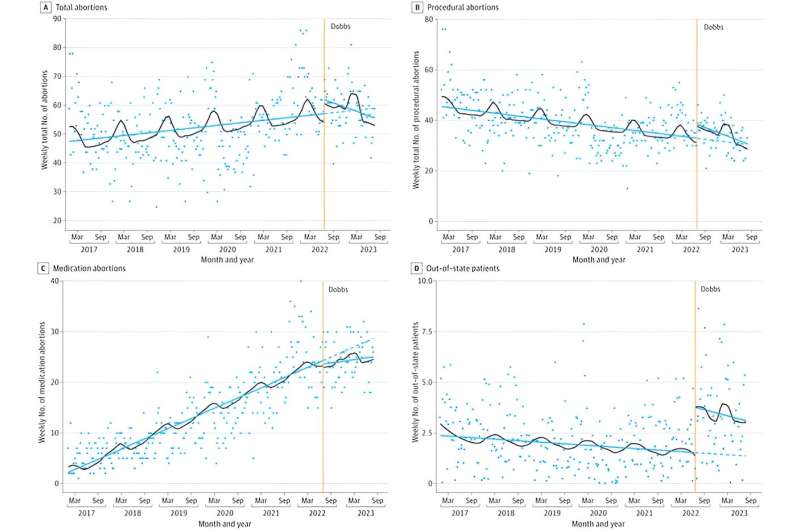This article has been reviewed according to Science X's editorial process and policies. Editors have highlighted the following attributes while ensuring the content's credibility:
fact-checked
peer-reviewed publication
trusted source
proofread
More out-of-state patients seek abortions in Washington state

More out-of-state women, largely from Texas and Alaska, are traveling to Washington state to obtain an abortion than were doing so before the U.S. Supreme Court struck down the constitutional right to abortion, according to research published today in JAMA Network Open.
The study tracked the number of abortions performed at the Cedar River Clinics, a large network of care sites in Washington state, both before and after the 2022 Dobbs decision.
Researchers found a 50% increase in out-of-state patients (from 4% to 6%) and documented an average one-week delay in care for all patients seeking abortion care.
"While one week delay does not sound significant, any delays in receiving abortion care are problematic because it adversely affects the health of the pregnant person," said Dr. Emily Godfrey, UW Medicine family medicine doctor and OB-GYN and the paper's senior author. The study's lead author, Taylor Riley, a University of Washington graduate student in the department of epidemiology, added context.
"This has concerning health and economic implications because delayed abortion care is associated with increased risk of complications and negative mental health impacts, and later abortion care is more expensive," she said.
Researchers reviewed the number of abortion procedures at Cedar River Clinics from January 1, 2017 through June 23, 2022. They compared those totals with the number of abortions from June 24, 2022, through July 31, 2023.
Before Dobbs, high proportions of out-of-state patients were from Alaska (52%), Montana (9%), Idaho (8%), Oregon (6%) and Texas (6%).
After Dobbs, the numbers changed: Out-of-state patients were largely from Texas (27%) and Alaska (26%), followed by Idaho (8%), Louisiana (6%) and Florida (6%). While Alaska still has abortion-rights protections, Texas, Idaho, Louisiana and Florida have severely limited the procedure, according to the Guttmacher Institute.
The researchers also found that post-Dobbs, a higher proportion of out-of-state patients sought procedural abortions (instead of medication) compared with in-state patients.
Godfrey surmised that "out-of-state patients are choosing uterine aspiration procedures over medication abortion in order to be 100% certain that they are no longer pregnant when they return home, especially if they live in a state that now criminalizes abortion."
A total of 18,379 abortions occurred during the study period, from January 1, 2017 to July 31, 2023. Of those abortions, 3,378 occurred in the post Dobbs study period or between June 24, 2022 to July 31, 2023.
Washington allows abortions up to the point of fetal viability or to protect the health of the pregnant individual. Because the state has longstanding laws to protect abortion, regulate insurance coverage, and allow abortion by a qualified health practitioner other than a doctor, Washington has become a haven for people seeking abortions, especially after 12 weeks, the authors noted.
"The increasing number of abortions, out-of-state patients and delays to care points to the need for increased investment in and resources for abortion care in Washington," Riley said. "This could include expanding the number of abortion-providing facilities and strengthening existing primary care and telehealth accessibility, financial support and referral systems within the state."
"Our proof-of-concept study showed that medical chart data can be used to assess statewide temporal changes in access and describe the sociodemographic makeup of the people experiencing the greatest delays in abortion care," Godfrey remarked. "The next step is to include more abortion facilities in this study to confirm our findings so that we can continue to provide critical information needed to effectively address health disparities related to abortion care in Washington state."
During the study period, 72% of the out-of-state patients had procedural abortions, and 28% had medication abortions. About 31% of the patients identified as white, while 23% identified as Black. Hispanic patients accounted for 14% of the abortions in the clinics, while 13% identified as Asian. Over half of the patients (61%) had children and 62% used public insurance. Persons who experienced a significant delay in abortion care of about one week included Latina, white and Black individuals. Asian individuals also experienced delays, but findings were not significant, the authors noted.
More information: Taylor Riley et al, Abortion Provision and Delays to Care in a Clinic Network in Washington State After Dobbs, JAMA Network Open (2024). DOI: 10.1001/jamanetworkopen.2024.13847





















